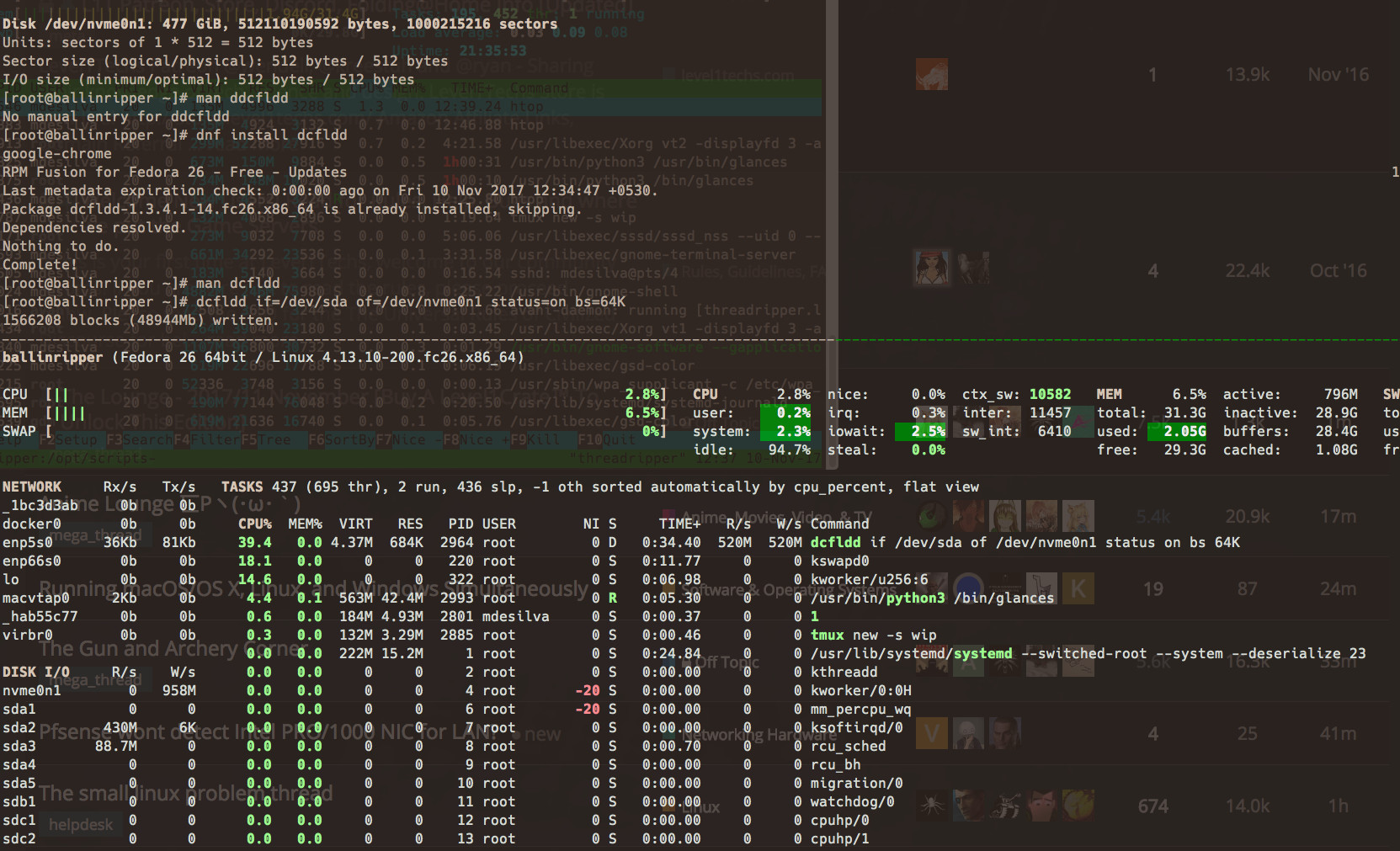That BIOS does not contain the new Agesa update. You need 0501 or higher to get it. Only 0503 or 0701 on Asus website have it. You should be able to use DOCP for your ram then, thus lowering your ram voltage.
Appreciate the advice mate - I normally flash the UEFI first thing, but for whatever reason the Asus Easy Flash couldn’t get a DHCP ip (huh?) - I’ll do it the manual way on a USB…
Mine would not recognize being connected to the internet until OS installed.
Try OC 3.8 at circa 1.23250v. By manually setting it will stabilize clock speeds and voltages which in turn will stabilize heat. In real world and all my testing, 3.8 was the sweet spot. XFR causes heat spikes and OC all cores negates XFR benefit.
I hope you can get that stable. My confidence in Corsair ram is zero.
Friday, 10th November 2017 – Cloning the boot Fedora 26 Install from the Samsung 850 PRO to a 960 PRO M.2 NVMe SSD
This was rather quick work, given that this wrote at almost 1 GB/s, which while it may be slow for the 960 PRO, remember its source SSD is not only the boot drive but also caps out ~550MB/s (read).
# Clone the AHCI SSD to the NVMe SSD
dcfldd if=/dev/sda of=/dev/nvme0n1 status=on bs=64K

However, there’s a catch. I spent most of the evening today trying to figure out why the NVMe drive alone would screw up booting Fedora 26. And then it dawned on me… dracut was the missing sauce!.
I don’t know about you, but Dracut is my least favorite program on the planet. That program is completely unintelligible and doesn’t even work as documented on the wiki.
reasons I keep wanting to move back to arch…
What was even more surprising though was the amount of Googling I had to do to find how to fix moving from AHCI > NVME for Fedora… and yeah, it took a good evening of much trial-error.
Thankfully that 1GB/s write to the NVMe SSD made it so much less painful…
Friday, 10th November 2017 – UEFI Update to 0701 ROG Zenith Extreme
Thought I’d also log steps taken here - dropped the CAP file from the website onto a USB flashed as FAT32
Here are the DDR4 OC settings and some Threadripper tuning (CPU SOC) etc. I later bumped the DDR4 DRAM voltage back to 1.48vdc
What is ‘Enumerate all IOMMU in IVRs’???
CC @wendell @Raziel – Would this help with some IOMMU curiosities I’ve seen on this board?
Success - The Aquantia 10G card & 960 PRO NVMe get their own IOMMU groups!
Setting “Enumerate all IOMMU in IVRs” as Enabled did the trick!
Nice.
I would run Asus RealBench and see if your ram is stable enough. It is a utility that comes with your MB.
BTW I just placed an order for a second Zenith Extreme. SOOOOO impressed by the hardware conveniences but most importantly UEFI polish.
Going to remove the Gigabyte board and most likely sell it (may be on the forums here) or eBay it off.
Will do - I will be running a host of stability tests a la Win 10 soon from -
- Cinebench
- AIDA64
- 3D Mark Timespy/Firestrike
- Unigen valley
- Tomb Raid benchmark
plus actual game time - stress CPU/RAM/GPU…
What about the Gigabyte board don’t you like? I’m almost ready to build a TR system. If you’re interested in selling here, I’d consider it if it’s not going to be problematic for passthrough.
It’s a pretty decent board - my only complaints would be that it seems like Gigabyte aren’t pumping out as many UEFI updates.
Plus, the DIMM.2 feature on the ROG is handy as I hate having to remove GPUs just to swap M.2 sticks. The DIMM.2 lets me swap 2 sticks if/when needed. It already came in super handy when cloning my Fedora 26 boot volume and migrating to the NVMe stick in the Zenith box.
Sure, I’ll PM you.